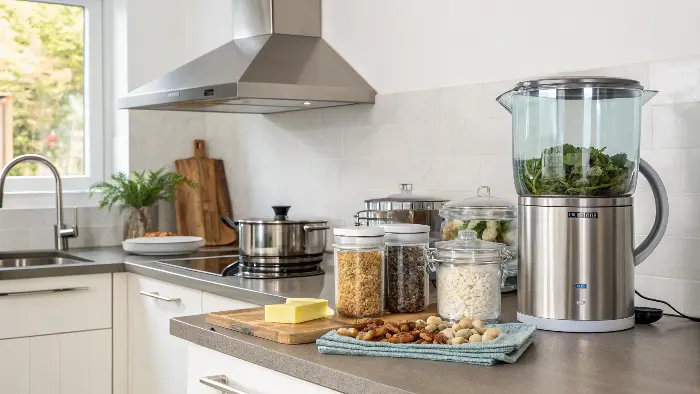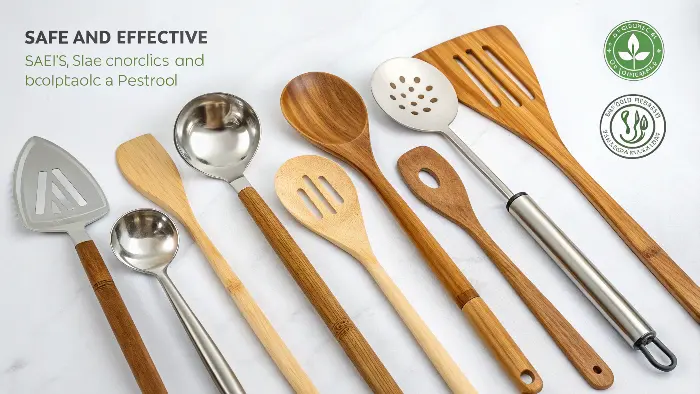Kitchen plastics a worry? Concerned about chemicals in your food? Identifying and replacing them is key for a healthier, safer home cooking environment.
To make your kitchen safer, pinpoint and replace items like black plastic utensils and non-stick cookware. Opt for alternatives such as stainless steel, cast iron, or glass to significantly reduce chemical exposure.
It’s wild when you start thinking about it, isn’t it? We spend so much effort choosing fresh ingredients, but what about the tools we cook and store them with? At Ecosourcecn, we’re all about sustainable and safe alternatives, and I’ve learned a ton about this. So, let’s break down how you can make your kitchen a much healthier space. Trust me, it’s easier than you think!
Are Black Plastic Kitchen Utensils Secretly Toxic, and What Should You Use Instead?
Using those black spatulas daily? Wondering if they’re leaching nasties? It’s a valid concern, but safer, durable alternatives are readily available.
Yes, some black plastic utensils, especially older or cheaper ones, can leach chemicals like colorants or recycled material contaminants when heated. Switch to stainless steel, wood, or silicone for peace of mind.
Okay, let’s talk about those ubiquitous black plastic utensils – the spatulas, the spoons, the turners. They’re everywhere, right? And they seem harmless enough. But I’ve got to tell you, my insight here is that black plastic utensils, especially those that come into contact with food or heat, should be high on your priority list for replacement. Why the concern specifically with black plastic?
The Trouble with Black Plastic
There are a couple of reasons:
- Recycled Content of Unknown Origin: Often, black plastic is used because it can hide a mix of recycled plastics of various colors and origins. Sometimes, this can include plastics from electronic waste or other non-food-grade sources, which might contain flame retardants (like brominated flame retardants) or heavy metals. These aren’t things you want near your food! I remember Jacky, our packaging specialist friend from Canada, being super strict about material traceability for anything food-contact. He’d always ask, "What’s in it, and where did it come from?" That kind of diligence is so important.
- Carbon Black and Other Additives: The "black" color often comes from an additive called carbon black. While food-grade carbon black is generally considered safe, the concern arises when the overall plastic matrix isn’t stable, especially with heat. The integrity of the base plastic matters a lot.
- Leaching Under Heat: The biggest issue is when these utensils are used for cooking. Heat can cause the plastic to degrade and release chemicals, including those colorants or contaminants from recycled content, directly into your lovely stir-fry or scrambled eggs. Not so appetizing! This is a key part of what my Chinese colleagues often emphasize from our insights: "最大限度地减少接触潜在有害化学物质和材料" – minimizing exposure to potentially harmful chemicals and materials. It’s a core principle for us.
So, What Are the Safer Swaps?
Luckily, there are fantastic alternatives that I personally love:
- Stainless Steel: This is my top pick for most things. It’s durable, non-reactive, super easy to clean, and practically lasts forever. A good set of stainless steel utensils is an investment that pays off.
- Wood (like bamboo or olive wood): These are naturally antimicrobial, gentle on non-stick pans (if you still have them, more on that later!), and they just look and feel nice. You do need to hand wash them and maybe oil them occasionally, but it’s worth it.
- Food-Grade Silicone: Make sure it’s 100% food-grade silicone without any fillers. It’s high-heat resistant and flexible, great for scraping bowls or using with non-stick surfaces.
Making this one switch can significantly reduce your family’s exposure to potentially harmful stuff. It’s a simple step, but honestly, it has a big impact on your daily peace of mind.Beyond Utensils, How Can You Make Your Entire Kitchen Less Toxic?
Worried about toxins beyond just your spoons? Feel overwhelmed by where to start? A few key changes can make your whole kitchen a healthier zone.
Reduce kitchen toxins by replacing non-stick cookware, using glass/stainless steel for food storage, and avoiding microwaving in plastic. Also, ensure good ventilation and filter your drinking water.

Alright, so we’ve tackled those black plastic utensils. But making your kitchen less toxic is a broader mission, and trust me, it’s totally doable. It’s not about achieving perfection overnight, but making conscious choices step-by-step. My insight here, and something I feel strongly about, is that non-stick cookware and plastic food storage are two other big areas to address. Let’s dive in.
Ditch the Dubious Non-Stick
Those pans that promise nothing will ever stick? I used to love them too! But many older ones (and some cheaper new ones) use coatings containing PFAS chemicals (like PFOA or PTFE, often known as Teflon). When these pans are overheated or scratched, these chemicals can be released into your food and the air. Not good. PFAS are often called "forever chemicals" because they don’t break down easily in the environment or our bodies, and they’re linked to a host of health problems. That realization was a bit of a shocker for me.
- What to use instead?
- Cast Iron: This is a true kitchen workhorse! It becomes naturally non-stick when seasoned properly, lasts for generations (I have my grandma’s!), and can even add a tiny bit of beneficial iron to your food.
- Stainless Steel (High Quality): Excellent for searing meats and general cooking. Learning to cook on stainless without sticking just takes a little practice with heat control and using enough healthy fats.
- Carbon Steel: Very similar to cast iron but lighter. It’s a favorite in professional kitchens for a reason.
- Ceramic-Coated (PFAS-free): If you really want that non-stick convenience, look for high-quality ceramic coatings that explicitly state they are free of PFAS, PFOA, PTFE, lead, and cadmium. Read the labels carefully!
Rethink Food Storage
Plastic containers are so convenient, I completely get it. But many can leach chemicals, especially when they hold fatty or acidic foods, or when they’re heated. This leads me to another key insight: for food storage, glass and stainless steel containers are far safer than plastic, and please, please avoid microwaving food in plastic containers, even if they claim to be "microwave-safe." The heat just accelerates any potential chemical transfer.
- Safer Storage Swaps:
- Glass Containers: These are my absolute favorite. Perfect for storing leftovers, meal prepping, and you can even bake in some of them. They don’t leach, don’t stain, and don’t hold onto food odors.
- Stainless Steel Containers: Lightweight, unbreakable, and great for packing lunches or storing dry goods in the pantry.
A Few More Quick Wins:
- Water Filter: Invest in a good water filter for your tap – for drinking and cooking. It can remove chlorine, lead, microplastics, and other common contaminants.
- Ventilation: Always use your exhaust fan when cooking, especially if you have a gas stove, to help remove airborne pollutants and cooking fumes.
- Cutting Boards: Consider wood (like maple or beech) or bamboo cutting boards over plastic ones. Plastic boards can get scarred easily, and those tiny grooves can harbor bacteria and shed microplastics into your food.
It’s about layering these small changes. Each one reduces your overall toxic load, making your kitchen a genuinely healthier hub for your family. It’s empowering!What Safe and Effective Tools Should Replace All Plastic Cooking Utensils?
Still using various plastic spoons and turners for cooking? Worried about what heat does to them? Fantastic, heat-safe alternatives exist for every kitchen task.
Replace all plastic cooking utensils with stainless steel, wood (bamboo, olive), or high-quality food-grade silicone. These materials don’t leach harmful chemicals into hot food and are more durable.

We’ve talked specifically about black plastic, but really, my advice extends to most plastic cooking utensils, especially those used with heat. You know, the colorful nylon ones, the clear polycarbonate ones? When they meet a hot pan or a simmering sauce, the risk of them breaking down and leaching chemicals or shedding microplastics just goes up. It’s one of those things where "better safe than sorry" really applies, especially when we’re talking about what goes into our bodies! As a company, Ecosourcecn is all about providing safer alternatives to everyday items, and this is a big one in the home. I feel it’s my responsibility to share what I’ve learned.
Why Ditch Plastic for Cooking?
- Heat Instability: Most plastics, even those marketed as "heat-resistant," have a temperature limit. Exceeding it, or even prolonged use near that limit, can cause them to soften, warp, and release unwanted substances. I’ve definitely seen plastic spatulas with those slightly melted, fuzzy edges – that melted bit had to go somewhere, right? Probably into the food. Yikes!
- Chemical Leaching: Beyond the base plastic (like nylon or polycarbonate), there are often additives – colorants, plasticizers, stabilizers. Heat is a great encourager for these chemicals to decide to migrate out of the plastic and into your meal.
- Microplastic Generation: Stirring, scraping, and general wear and tear can release tiny plastic particles (microplastics) directly into your food. The long-term health effects of ingesting microplastics are still being heavily studied, but it’s definitely not something we want to be knowingly adding to our family’s diet.
Your Go-To Safe Cooking Utensil Arsenal:
Building a collection of these will cover pretty much any cooking task you have. It doesn’t have to be expensive or happen all at once. Material Pros Cons Best For Stainless Steel Extremely durable, non-reactive, dishwasher safe, totally heatproof Can scratch some delicate non-stick surfaces (if you still use them) Almost everything: stirring, flipping, serving, whisking, mashing. Essential! Wood/Bamboo Gentle on all cookware, naturally beautiful, often antimicrobial properties Requires hand washing; can dry out or absorb strong odors/stains if not cared for Stirring sauces, scraping pans, serving salads; great with non-stick or delicate surfaces. Silicone (100% Food-Grade) Very flexible, high heat resistance, non-stick friendly, easy to clean, comes in fun colors Quality varies hugely; ensure it’s 100% food-grade without plastic fillers (do the "pinch test" – if it turns white, it has fillers) Scraping bowls clean, stirring sticky stuff, spatulas for non-stick pans, baking applications. I personally love my collection of wooden spoons—each one has a story—and a few really sturdy stainless steel turners and ladles. It just feels better knowing my tools aren’t potentially working against my efforts to cook healthy, nourishing meals. It’s a simple switch, but it’s one that compounds its benefits over every single meal you prepare. You can do this!
Conclusion
Detox your kitchen by swapping risky plastics for safer materials. Small changes in utensils, cookware, and storage make a big difference for your family’s health.


